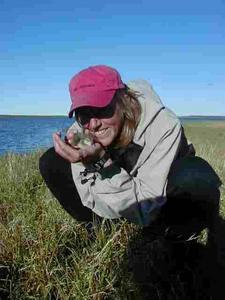
|
|
13 July, 2002
Started the day with a phone call to Robert Suydam (primary investigator or
researcher from Barrow) and got some good news or bad news, depending on
the perspective. Because of the hurry all the birds were in this year -
early incubation and hatching - we will be finished here earlier than
planned. The word is that I'll probably be helicoptered back to Barrow
towards the end of this coming week! Life may not be in frenzy here on the
North Slope, but I now am.
To begin with, why will we be done early? The research I am involved in is
studying the breeding biology of King Eiders, Tundra Swans and
White-fronted geese. Within this study, we began by observing which areas
of our study region the birds preferred. From there, we began searching
those areas looking for nests. When we found the nests, we measured the
length, width and mass of each egg. We also recorded the latitude and
longitude, and in some of the nests, we inserted tiny computer pieces
called Hobo Temps that would record incubation temperatures and variations.
With that information, Rebecca and Robert will be able to calculate average
nest size and incubation practices. In addition, we continued to re-visit
nests to see if any had been depredated by predators, such as gulls or
foxes. If a nest was depredated, we did a preliminary (practice) habitat
evaluation of the nest site and collected down for future genetic studies.
At this point, almost every nest that avoided predation has hatched. We
are currently trying to trap a couple of the last hens to attach a
radio transmitter, then follow her and her chicks as they move northward
before fall migration. There has not been much success with this, yet -
one transmitter attached, and only 2 other possible birds to trap. After
all eggs are hatched (which will be in the next couple of days), the only
thing we have left to do is a final habitat evaluation for each nest site.
This won't take many days, so it looks like work is wrapping up. That
thought is really difficult to comprehend at this time.
After hearing that this morning, I was even more anxious to get the day
started. As I walked out toward Twin Lakes, I realized that this could be
the last time I am actually in that specific area. I am excited about
returning to civilization and getting prepared for the upcoming school
year, but I am not sure I am ready to end this experience. There is so
much left to learn - to see, to smell, to feel, to question. Much of this
job is rewarding, but much of it also leaves you wanting just a little
more. For example, I've only been fortunate enough to see one of the
tundra swan nests filled with the baby cygnets. I've only seen the
goslings swimming down the creek one time. I only saw my first baby
ptarmigan this morning. I still haven't seen any king eider ducklings. It
is like I've spent the whole summer watching over these precious birds, but
am not allowed to enjoy the final product of new life. I can tell as I
look around or sit and listen, that it is time to move on. The landscape
is quieting down, the skies hold fewer birds, and the flowers are beginning
to seed out. Life is preparing for the next stage - I guess that is the
hint for me to prepare, as well. As I spend my next week, I hope to be
able to take advantage of all the new lessons the wildlife provides- enjoy
it to its fullest, but leave with no regrets of things undone or unlearned.
I will attempt to cherish everything - the sunlight, the loon calls, and
maybe even the tenacity of the mosquitoes. I hope you will stay with for
the making of the final memories.
PS Took an evening walk down to a close lake to attempt trapping a hen.
Instead, the eggs were already hatched so I got to end my day holding King
Eider Ducklings!

This is a king eider duckling - probably only a couple of hours old. Almost as cute as the swan cygnets. This is my first king eider duckling I've had a chance to see. --

Aren't we cute! It was so neat being able to hold this little duckling! --
Contact the TEA in the field at
.
If you cannot connect through your browser, copy the
TEA's e-mail address in the "To:" line of
your favorite e-mail package.
|
